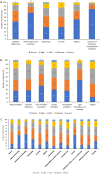Advanced Parkinson's disease treatment patterns in Italy: an observational study interim analysis
- PMID: 38381654
- PMCID: PMC10883087
- DOI: 10.1080/07853890.2024.2315226
Advanced Parkinson's disease treatment patterns in Italy: an observational study interim analysis
Abstract
Background: Oral levodopa remains the mainstay of treatment for Parkinson's disease (PD). However, as PD progresses, response to treatment may fluctuate. Managing fluctuations can be demanding for clinicians and patients. There is a paucity of real-world studies reporting on PD management in patients with fluctuations in treatment response, especially in patients with advanced stages of PD. The multicentre, observational Parkinson's Disease Fluctuations treatment PAthway (PD-FPA) study describes the real-life management of response fluctuations in Italian patients with advanced PD.
Patients and methods: PD-FPA had a retrospective and prospective phase; herein, retrospective results are presented. Ten Italian centres enrolled patients with a PD diagnosis from 10-15 years prior to study entry (T0) and who had ≥2-year history of fluctuations. Data on patient demographics, medical history, PD stage, fluctuation characteristics, symptoms, and prescribed treatments were collected at T0 and retrospectively (2 years prior to T0) via patient chart review/interview.
Results: Overall, 296 patients (60% male, mean age 68 years, 84% with Hoehn and Yahr scores 2-3) were enrolled. At T0, most patients (99.3%) were on oral levodopa therapy. All patients used dopaminergic medications; adjunctive medications included dopamine agonists (56%) and monoamine oxidase B (60%) and catechol-O-methyltransferase enzyme inhibitors (41%). At T0, 51% of patients had changed therapy, with response fluctuations being the most common reason (74%); wearing-off was the most common fluctuation (83%).
Conclusion: This interim analysis of PD-FPA suggests that adequate levodopa dosing and adjunctive medications can stabilize advanced PD and provide patients with a good quality of life.
Keywords: COMT inhibitor; MAO-B inhibitor; levodopa; motor/non-motor fluctuations; parkinson disease.
Plain language summary
Patients with Parkinson’s disease (PD) often exhibit fluctuations in their response to oral levodopa; however, real-world studies on the management of these fluctuations are lacking. This planned interim analysis of the real-world, multicentre, observational PD Fluctuations treatment Pathway (PD-FPA) study found that adequate levodopa dosing and adjunctive medications can stabilize Italian patients with advanced PD and improve their quality of life.
Conflict of interest statement
FS received honoraria as a consultant or fees for oral scientific presentations from Lundbeck, UCB, Novartis, Chiesi Farmaceutici, GSK, Britannia Pharmaceuticals, Zambon, Cynapsus Therapeutics Inc., SynAgile, Sunovion, Biogen, Neuroderm Ltd., BIAL, Roche, and EVER Pharma. RC has received fees for oral scientific presentations from UCB, Zambon, Lusofarmaco, and AbbVie. LL has received honoraria for lecturing or travel grants from Medtronic, UCB, AbbVie, Zambon, and Lusofarmaco. MP has received honoraria as a consultant from Boston Scientific, AbbVie, and EVER pharma. AT has received honoraria for acting as a consultant on advisory boards for BIAL, UCB, and AbbVie; has received speakers’ fees from BIAL, UCB, Lusofarmaco, Chiesi Farmaceutici, AbbVie, and Zambon; has served on the editorial board of
Figures





References
Publication types
MeSH terms
Substances
LinkOut - more resources
Full Text Sources
Other Literature Sources
Medical
Miscellaneous
